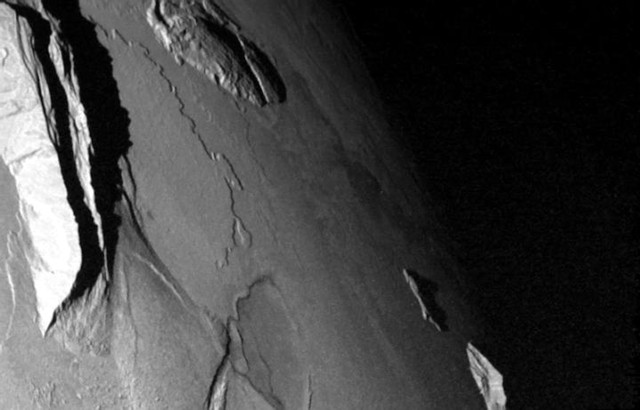
by Mary Caperton Morton Tuesday, August 16, 2016

Io's Mongibello Mons (at left) rises 8.6 kilometers — nearly the height of Mount Everest — above the volcanic plain, but unlike Everest, which is surrounded by the Himalayas, Mongibello Mons stands alone. Credit: NASA/JPL/University of Arizona.
Jupiter’s innermost moon, Io, is home to some of the strangest mountains in our solar system: towering isolated peaks, some more than 8,000 meters tall, that jut from the moon’s surface with little evidence of underlying tectonics. Now, a new model may explain how Io’s odd peaks formed.
Io is the most volcanically active body in our solar system, with more than 400 active low-lying volcanoes — separate from the towering isolated peaks — that have covered the moon’s entire surface with sulfurous lava flows. These eruptions are ongoing, adding about 12 centimeters of fresh lava to the surface each decade and masking visible surface evidence of deeper tectonic processes.
“The planetary community has thought for a while that Io’s mountains might be a function of the fact that it is continuously erupting lava over the entire sphere,” said William McKinnon of Washington University in St. Louis and co-author of a new study in Nature Geoscience in a statement. “All that lava spewed on the surfaces pushes downward and, as it descends, there’s a space problem because Io is a sphere, so you end up with compressive forces that increase with depth.”
McKinnon and colleagues modeled the effects of these large compressive forces and found that the strain they cause tends to localize along isolated fractures that produce faults running from deep in the moon’s lithosphere up to the surface. When these faults breach the surface, they provide pathways for magma to erupt, building the isolated peaks, McKinnon said. As magma continues to erupt along the isolated cracks over time, Io’s lonely mountains grow taller and taller.
This mountain-building process has not been observed anywhere else in the solar system, but it could hint at a process that might have been at work on early Earth, “when it was very young and entirely covered by a shallow ocean,” McKinnon said. “Because there was still lots of volcanism, mountains like those on Io might have burst through the ocean. They might have been the first emergent land on Earth.”
© 2008-2021. All rights reserved. Any copying, redistribution or retransmission of any of the contents of this service without the expressed written permission of the American Geosciences Institute is expressly prohibited. Click here for all copyright requests.